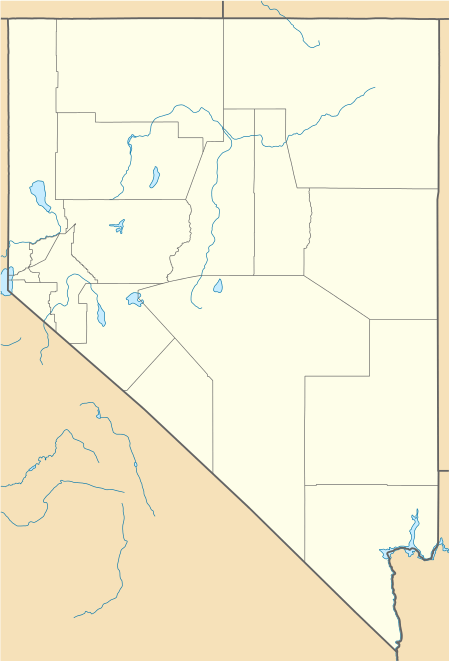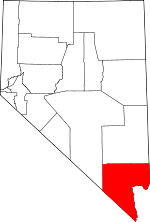Arden, Nevada
Arden, Nevada was an unincorporated community in Clark County, Nevada. The area is now part of the town of Enterprise.[2] Located about 7 miles (11 km) southwest of Las Vegas, the area is experiencing rapid growth in housing development on land formerly owned by the Bureau of Land Management.
Arden | |
|---|---|
Unincorporated community | |
View of Arden from the west, with Henderson in the distance. | |
 Arden | |
| Coordinates: 36°01′05″N 115°13′48″W | |
| Country | United States |
| State | Nevada |
| County | Clark |
| Founded | 1905 |
| Named for | Arden |
| Elevation | 2,484 ft (757 m) |
| Time zone | UTC-8 (PST) |
| • Summer (DST) | UTC-7 (PDT) |
| ZIP code | 89118 |
| GNIS feature ID | 838496 |
History
The San Pedro, Los Angeles and Salt Lake Railroad (later part of the Union Pacific Railroad) began operating through the area in 1905.[3] The railroad's Arden station, located about 12 miles (19 km) south of Las Vegas, was named for Arden, the New York estate of E. H. Harriman, the railroad's co-owner.[4][5] By 1906, Arden was serving as a shipping point for the Potosi mine.[6][7]
The Arden post office was established in 1907.[8] Around that time, William K. Moore, who has been credited as Arden's founder, discovered gypsum deposits in the nearby mountains.[9] With financing from Southern California businessmen, Moore started the Arden Plaster Company, which opened a mill at the site in 1908.[9][10] It was reported to be the second largest gypsum plant in the country.[10] A narrow-gauge railroad was constructed to connect the plant to the gypsum mine, 5 miles (8.0 km) away.[11]
The plaster plant burned down in 1912, but was quickly rebuilt.[9][12][13] In 1919, it was purchased by the United States Gypsum Company.[14] The plant was closed and dismantled in 1930 due to a decline in the construction industry.[15]
A railroad spur line was built in 1925 to connect Arden to the Blue Diamond Mine, 11 miles (18 km) to the northwest.[16]
A gravel pit was established at Arden in the mid-1950s, and operated until 1978, growing to 160 acres (65 ha) in size.[17]
Clark County built a fallout shelter at Arden in the 1950s or 1960s to house regional government leaders in case of an attack on Las Vegas.[18][19] The shelter was maintained at least until the 1980s.[19]
In 1958, United Airlines Flight 736, a Douglas DC-7 passenger aircraft, collided with a United States Air Force F-100 jet fighter near Arden, killing all 49 people aboard the two aircraft.[20]
The Arden post office was closed in 1971.[21] In 1981, Arden was reported to have around 40 residents.[9]
References
- "US Board on Geographic Names". United States Geological Survey. 2007-10-25. Retrieved 2008-01-31.
- "Map of Unincorporated Towns" (PDF). Clark County. Retrieved 2018-06-04.
- David F. Myrick (1963). Railroads of Nevada and Eastern California: The Southern Roads. Howell-North Books. p. 647.
- Nolan Listerview (August 6, 2012). "Former township steeped in history of Union Pacific Railroad". Las Vegas Review-Journal. Retrieved 2018-06-04.
- David F. Myrick (1963). Railroads of Nevada and Eastern California: The Southern Roads. Howell-North Books. p. 760.
On the other hand, there is possible evidence of an affiliated Harriman influence in the designation of certain of the station names. One of these, an original small station twelve miles south of Las Vegas, was called Arden, possibly in honor of Harriman's luxurious estate in New York.
- "Schwab buys the old Potosi". Reno Gazette-Journal. January 9, 1906 – via Newspapers.com.
- "Arden". Las Vegas Age. April 14, 1906. p. 6. Retrieved 2018-06-04 – via Las Vegas-Clark County Library District.
- Helen S. Carlson (1974). Nevada Place Names: A Geographic Dictionary. University of Nevada Press. p. 40. ISBN 9780874170948.
- Katherine Sheehey (May 10, 1981). "Gypsum strike built tiny Arden". Las Vegas Review-Journal. p. 6J.
- "Immense plant". Las Vegas Age. January 18, 1908. p. 1. Retrieved 2018-06-04 – via Las Vegas-Clark County Library District.
- "The Arden Plaster Company". Salt Lake Mining Review. February 15, 1908 – via Newspapers.com.
- "Big plaster mills burned at Arden". Reno Evening Gazette. May 10, 1912 – via Newspapers.com.
- "Arden plaster mill". Las Vegas Age. June 1, 1912. Retrieved 2018-06-04 – via Las Vegas-Clark County Library District.
- "Mine, mill, and general construction news". Salt Lake Mining Review. August 15, 1919 – via Newspapers.com.
- "Bureau of Mines reports gypsum output less". Reno Evening Gazette. March 24, 1931 – via Newspapers.com.
- David F. Myrick (1963). Railroads of Nevada and Eastern California: The Southern Roads. Howell-North Books. p. 761.
- "BLM closes Arden sand, gravel pit". Las Vegas Review-Journal. May 26, 1978. p. 15A.
- Henry Brean (July 14, 2013). "Take a tour of a quaint Cold War relic, the bunker". Las Vegas Review-Journal. Retrieved 2018-06-04.
- Dale Pugh (May 31, 1981). "Arden bunker serves as disaster command center". Las Vegas Review-Journal. p. 1B.
- Accident description for DC-7 and F-100 collision at the Aviation Safety Network
- James Gamett; Stanley W. Paher (1983). Nevada Post Offices: An Illustrated History. Nevada Publications. p. 35.
